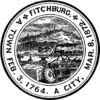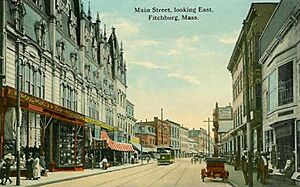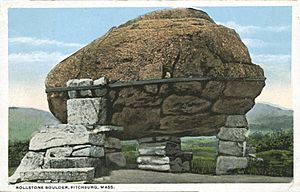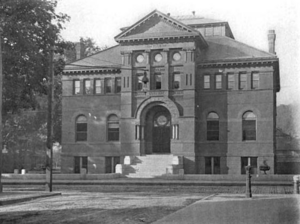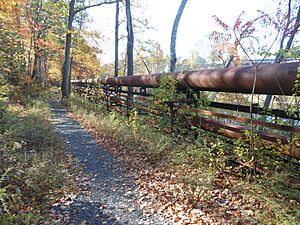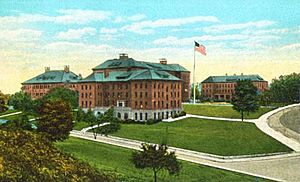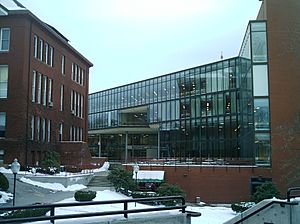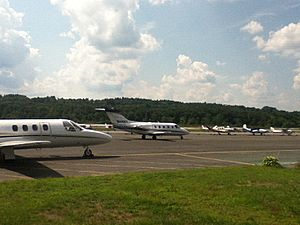Fitchburg, Massachusetts facts for kids
Quick facts for kids
Fitchburg, Massachusetts
|
|||
|---|---|---|---|

Downtown Fitchburg seen from the south
|
|||
|
|||
| Nickname(s):
City by the River, The Burg, The Dirty 'Burg (Derogatory, occasionally endearing)
|
|||
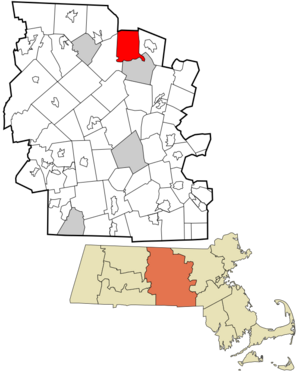
Location in Worcester County and the state of Massachusetts.
|
|||
| Country | United States | ||
| State | Massachusetts | ||
| County | Worcester | ||
| Settled | 1730 | ||
| Incorporated (town) | 1764 | ||
| Incorporated (city) | 1872 | ||
| Government | |||
| • Type | Mayor–council | ||
| Area | |||
| • Total | 28.12 sq mi (72.82 km2) | ||
| • Land | 27.82 sq mi (72.06 km2) | ||
| • Water | 0.29 sq mi (0.76 km2) | ||
| Elevation | 482 ft (143 m) | ||
| Population
(2020)
|
|||
| • Total | 41,946 | ||
| • Density | 1,507.55/sq mi (582.07/km2) | ||
| Time zone | UTC−5 (Eastern) | ||
| • Summer (DST) | UTC−4 (Eastern) | ||
| ZIP Code |
01420
|
||
| Area code(s) | 351/978 | ||
| FIPS code | 25-23875 | ||
| GNIS feature ID | 0617121 | ||
| Website | www.fitchburgma.gov | ||
Fitchburg is a city in northern Worcester County, United States. It's the third-largest city in the county. In 2020, about 41,946 people lived here. Fitchburg State University is also located in the city.
Contents
History of Fitchburg
Fitchburg was first settled by Europeans in 1730. It was part of Lunenburg at that time. In 1764, it became its own town. Before that, the Nipmuc tribe lived in the area. The city is named after John Fitch. He was part of the group that helped make Fitchburg a separate town. In 1748, John Fitch and his family were taken to Canada by Native Americans. Luckily, they returned the next year.
Fitchburg is located on the Nashua River and a railroad line. The original Fitchburg Railroad went through the Hoosac Tunnel. This tunnel connected Boston and Albany, New York. The Burleigh Rock Drill, made in Fitchburg, helped build the tunnel.
In the 1800s, Fitchburg was a busy industrial city. Mills used water power from the river. They made machines, tools, clothes, paper, and even firearms. The city is known for its beautiful Victorian buildings. These were built when the city's mills were doing very well. Examples include the Fay Club and the old North Worcester County Courthouse.
In 1922, the mills in Fitchburg closed during the 1922 New England Textile Strike. This happened because of a planned wage cut. Fitchburg is one of two county seats in Worcester County. It has hosted the Northern Worcester County Registry of Deeds since 1903.
In 1961, two movies filmed scenes in Fitchburg. These were Return to Peyton Place and By Love Possessed.
Geography of Fitchburg
Fitchburg covers about 28.1 square miles (72.8 square kilometers). Most of this is land, with a small part being water. The Nashua River flows through the city. The highest point in Fitchburg is Brown Hill. It is about 1,210 feet (369 meters) above sea level.
Fitchburg shares borders with several other towns:
- Ashby to the north
- Lunenburg to the east
- Leominster to the south
- Westminster to the west
- A small part of Ashburnham to the northwest
Fitchburg's Neighborhoods
Fitchburg has many different neighborhoods and villages. Some of these include:
- Cleghorn
- Crockerville
- College Area
- Downtown Fitchburg
- East Side
- Green Acres Village
- North Fitchburg
- The Patch
- Prichard-Pleasant Street
- South Fitchburg
- Tar Hill
- Upper Common
- Waite's Corner
- West Fitchburg
Fitchburg's Climate
Fitchburg has a humid continental climate. This is common for Massachusetts and New England. Summers are usually warm, rainy, and humid. Winters are cold, windy, and snowy. Spring and fall are generally mild. However, conditions can change a lot depending on the wind.
The warmest month is July. The average high temperature is about 84°F (29°C). The average low is about 63°F (17°C). January is the coldest month. The average high is about 35°F (2°C). The average low is about 17°F (-8°C).
| Climate data for Fitchburg Municipal Airport, Fitchburg, Massachusetts (1998–2020 normals); Snow: Fitchburg COOP (2016–2023) | |||||||||||||
|---|---|---|---|---|---|---|---|---|---|---|---|---|---|
| Month | Jan | Feb | Mar | Apr | May | Jun | Jul | Aug | Sep | Oct | Nov | Dec | Year |
| Record high °F (°C) | 70 (21) |
80 (27) |
89 (32) |
94 (34) |
98 (37) |
99 (37) |
103 (39) |
100 (38) |
96 (36) |
87 (31) |
78 (26) |
74 (23) |
103 (39) |
| Mean maximum °F (°C) | 57 (14) |
57 (14) |
68 (20) |
82 (28) |
90 (32) |
92 (33) |
94 (34) |
93 (34) |
89 (32) |
79 (26) |
70 (21) |
61 (16) |
96 (36) |
| Mean daily maximum °F (°C) | 34.8 (1.6) |
38.0 (3.3) |
46.3 (7.9) |
59.2 (15.1) |
70.0 (21.1) |
78.1 (25.6) |
83.9 (28.8) |
82.3 (27.9) |
75.4 (24.1) |
62.2 (16.8) |
50.9 (10.5) |
40.2 (4.6) |
59.5 (15.3) |
| Daily mean °F (°C) | 25.8 (−3.4) |
28.3 (−2.1) |
36.4 (2.4) |
48.0 (8.9) |
58.8 (14.9) |
67.5 (19.7) |
73.3 (22.9) |
71.6 (22.0) |
64.2 (17.9) |
51.5 (10.8) |
41.2 (5.1) |
31.5 (−0.3) |
49.3 (9.6) |
| Mean daily minimum °F (°C) | 16.9 (−8.4) |
18.6 (−7.4) |
26.5 (−3.1) |
36.8 (2.7) |
47.5 (8.6) |
56.9 (13.8) |
62.7 (17.1) |
60.9 (16.1) |
53.1 (11.7) |
40.8 (4.9) |
31.4 (−0.3) |
22.7 (−5.2) |
39.1 (3.9) |
| Mean minimum °F (°C) | −2 (−19) |
2 (−17) |
8 (−13) |
25 (−4) |
34 (1) |
44 (7) |
53 (12) |
50 (10) |
38 (3) |
26 (−3) |
17 (−8) |
4 (−16) |
−4 (−20) |
| Record low °F (°C) | −10 (−23) |
−15 (−26) |
−12 (−24) |
15 (−9) |
29 (−2) |
36 (2) |
47 (8) |
45 (7) |
28 (−2) |
15 (−9) |
7 (−14) |
−7 (−22) |
−15 (−26) |
| Average precipitation inches (mm) | 2.62 (67) |
3.01 (76) |
3.94 (100) |
3.79 (96) |
3.74 (95) |
4.59 (117) |
3.47 (88) |
3.49 (89) |
3.97 (101) |
4.46 (113) |
3.27 (83) |
3.41 (87) |
44.45 (1,129) |
| Average snowfall inches (cm) | 15.1 (38) |
17.8 (45) |
18.6 (47) |
2.9 (7.4) |
0 (0) |
0 (0) |
0 (0) |
0 (0) |
0 (0) |
0.8 (2.0) |
3.1 (7.9) |
17.5 (44) |
70.7 (180) |
| Source: https://www.weather.gov/wrh/climate?wfo=box | |||||||||||||
People of Fitchburg
| Historical population | ||
|---|---|---|
| Year | Pop. | ±% |
| 1790 | 1,151 | — |
| 1800 | 1,390 | +20.8% |
| 1810 | 1,566 | +12.7% |
| 1820 | 1,736 | +10.9% |
| 1830 | 2,169 | +24.9% |
| 1840 | 2,604 | +20.1% |
| 1850 | 5,120 | +96.6% |
| 1860 | 7,805 | +52.4% |
| 1870 | 11,260 | +44.3% |
| 1880 | 12,429 | +10.4% |
| 1890 | 22,037 | +77.3% |
| 1900 | 31,531 | +43.1% |
| 1910 | 37,826 | +20.0% |
| 1920 | 41,029 | +8.5% |
| 1930 | 40,692 | −0.8% |
| 1940 | 41,824 | +2.8% |
| 1950 | 42,691 | +2.1% |
| 1960 | 43,021 | +0.8% |
| 1970 | 43,343 | +0.7% |
| 1980 | 39,580 | −8.7% |
| 1990 | 41,194 | +4.1% |
| 2000 | 39,102 | −5.1% |
| 2010 | 40,318 | +3.1% |
| 2020 | 41,946 | +4.0% |
| 2023 | 41,579 | −0.9% |
Source: United States Census records and Population Estimates Program data. Source: |
||
In 2010, Fitchburg had 40,318 people living in 15,165 households. About 29% of households had children under 18. The average household size was 2.49 people. The average family size was 3.10 people.
The median age in the city was 34.7 years. About 22.9% of the population was under 18. About 14.1% were between 18 and 24. For every 100 females, there were about 94.5 males.
Most people in Fitchburg spoke English (76.9%). Spanish was spoken by 15.1% of residents. Other languages included Indo-European languages (4.2%) and Asian/Pacific Islander languages (2.6%).
Economy in Fitchburg
In the early 1900s, Fitchburg was known for its paper industry. Many paper mills were located along the Nashua River. They employed a large number of immigrants. People who lived there sometimes said the river would change color. This was due to the dyes used by the paper mills.
Here are some businesses with ties to Fitchburg:
- The Wachusett Potato Chip Company started in 1939. It bought the old County Jail buildings in the 1940s. Today, it still makes chips under the Wachusett name.
- Two truck companies, Wachusett Truck Company and New England Truck Company, operated here. This was in the early 1900s.
- Simonds International, a saw manufacturer, was founded in Fitchburg in 1832. It still operates today.
- The Iver Johnson Arms and Cycle Works made motorcycles for a short time. Their main products were firearms and bicycles.
- Assumption Life, a financial services company, began in Fitchburg in 1903. It later moved to Moncton, New Brunswick.
- The Great Wolf Lodge New England opened in June 2014. This project created over 400 new jobs.
Fitchburg Central Steam Plant
The Fitchburg Central Steam Plant, also called the PLT, was built in 1928. It provided steam and electricity to local paper mills. When the mills closed, the plant was no longer used.
In 2008, the EPA called the plant a "brownfield site." This meant the soil and groundwater were polluted. The EPA gave Fitchburg $50,500 to help clean up the site. Cleanup started in 2010. By December 2015, the plant was torn down. Its large smokestack was the last part to fall.
Arts and Culture in Fitchburg
The Fitchburg Art Museum opened in 1925. It has over 20,000 square feet (1,858 square meters) of space. The museum features American, African, Egyptian, Greek, and Roman art.
The Rollstone Boulder is a huge 110-ton rock. It is made of granite. The boulder used to be on top of Rollstone Hill. In 1929 and 1930, it was moved and put back together in a public park.
The Fitchburg Historical Society keeps over 200,000 items. These items tell the story of Fitchburg's history. They include old newspapers, photos, and family histories.
The Fitchburg Public Library started in 1859. In 1899, it opened one of the country's first children's rooms. This was a special library service just for kids. In 1962, it became the first regional library in the Massachusetts Regional Library System.
Other cultural spots include:
- Arthur J. DiTommaso Memorial Bridge
- The Finnish Center at Saima Park
- Wallace Civic Center of Fitchburg State University
Parks and Recreation in Fitchburg
Fitchburg has many parks and places for fun:
- Coggshall Park is a 300-acre (121-hectare) park. It opened in 1894. It has wooded trails, Mirror Lake, a walking path, and a playground. You can also play disc golf there.
- Flat Rock Wild Life Sanctuary is a 326-acre (132-hectare) wildlife area.
- Fitchburg Abolitionist Park was created in 2017. Volunteers made it to honor the city's anti-slavery history. Fitchburg played a role in the Underground Railroad.
- West Fitchburg Steam Line Trail is a path for bikes and walking. It is 0.6 acres (0.24 hectares) long. It runs along the Nashua River.
- Crocker Field is a sports facility. It is listed on the National Register of Historic Places.
- Coolidge Park is a multi-use park. It has two street hockey rinks and four baseball/softball fields. There is also a swimming pool and a walking path.
- Fitchburg Dog Park is a 1-acre (0.4-hectare) fenced park. Dogs can run off-leash here. It is located within Coolidge Park.
Education in Fitchburg
Fitchburg has many schools for students of all ages.
Elementary Schools
- Crocker Elementary School
- South Street Elementary School
- Reingold Elementary School
Middle Schools
- Memorial Middle School
- Longsjo Middle School
High Schools
- Fitchburg High School
- Goodrich Academy
- McKay Arts Academy
- Montachusett Regional Vocational Technical School, also called Monty Tech
- Sizer School
Private Schools
- Applewild School
- Notre Dame Preparatory School
- St. Bernard's Elementary School
- St. Bernard's Central Catholic High School
St. Anthony of Padua School opened around 1951. It closed in 2017. This left Fitchburg with only one Roman Catholic grade school.
Colleges and Universities
- Fitchburg State University
This university was started in 1894. It began as the State Normal School in Fitchburg.
Media in Fitchburg
Newspapers
- Raivaaja
- Sentinel & Enterprise
Television
Fitchburg has its own TV station, Fitchburg Access Television (FATV). It covers local events. These include school sports and city government meetings. FATV has three channels: Public, Education, and Government (PEG). You can watch FATV on Comcast (channels 8, 9, & 99) and Verizon (channels 35, 36, & 37).
Radio
- WPKZ, AM-1280 FM-105.3 (started in 1941)
- WXPL, FM-91.3 (Fitchburg State Radio)
- WXLO, FM-104.5
- WQPH, FM-89.3 (Catholic Radio affiliate)
City Services and Transportation
Fire Department
The Fitchburg Fire Department has 81 firefighters. They work from three stations. They respond to about 12,000 emergency calls each year.
Law Enforcement
- Fitchburg Police Department is responsible for 28 square miles (73 square kilometers) of the city. They respond to over 40,000 incidents every year.
- Worcester County Sheriff's Office
- Massachusetts State Police
Medical Care
UMass Memorial Health runs a hospital in Fitchburg.
Transportation
The Montachusett Regional Transit Authority (MART) provides most transportation in Fitchburg. MART offers bus services and shuttle services. It also connects to the MBTA Commuter Rail line. You can catch the train at Fitchburg Station and Wachusett Station. Fitchburg Station is near the end of the Fitchburg Line from Boston. Wachusett Station is the very last stop.
The Fitchburg Municipal Airport covers 335 acres (136 hectares). It is near the Leominster border. The land for the airport was given to the city in 1940. It serves the greater Fitchburg area.
Notable People from Fitchburg
Many interesting people have connections to Fitchburg:
- Amerie (Amerie Mi Marie Rogers), a singer and actress.
- Michael Beasley, an NBA player.
- Ron Bouchard, a former NASCAR driver.
- Donald Featherstone, who created the famous plastic flamingo lawn ornament.
- Ryan Gomes, another NBA player.
- Hiram Maxim, who invented the first self-powered machine gun.
- George Noory, host of Coast to Coast AM radio show.
- Eleanor Norcross, who founded the Fitchburg Art Museum.
- Joseph Pilato, an actor.
- Charles L. Robinson, the first governor of Kansas.
- Sylvanus Sawyer, an inventor and manufacturer.
- Asa Thurston, a missionary to Hawaii.
Sister Cities
Fitchburg has "sister city" relationships with other cities around the world. These partnerships help promote cultural exchange.
See also
 In Spanish: Fitchburg (Massachusetts) para niños
In Spanish: Fitchburg (Massachusetts) para niños



